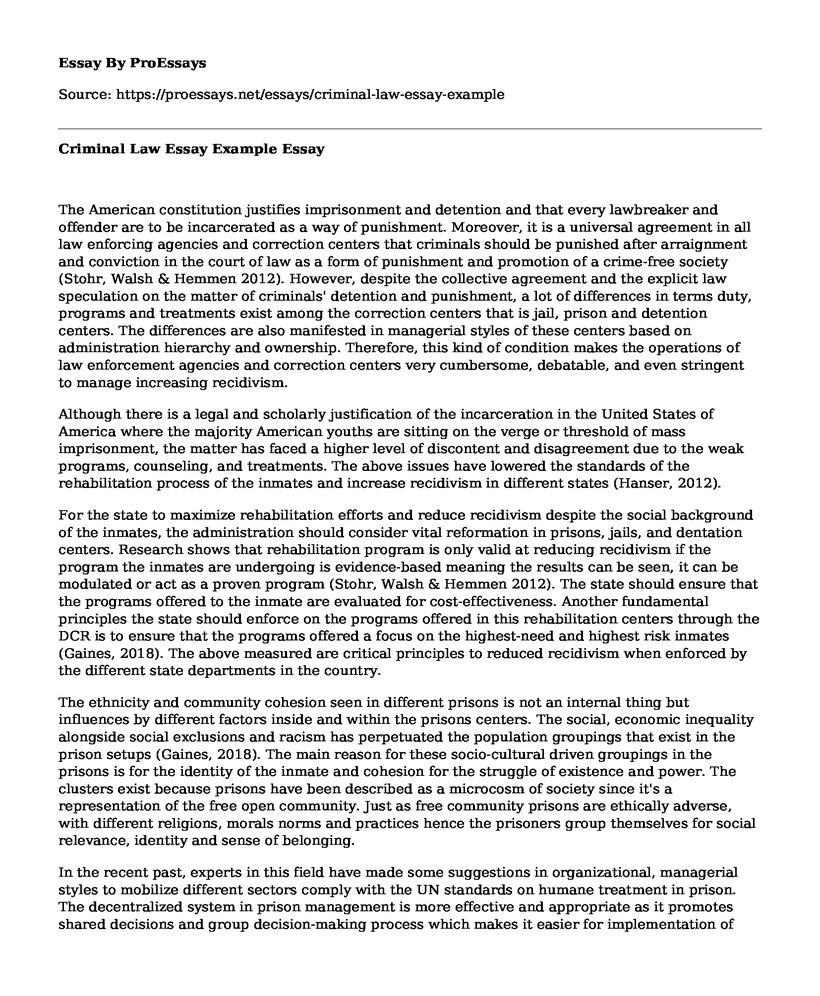The American constitution justifies imprisonment and detention and that every lawbreaker and offender are to be incarcerated as a way of punishment. Moreover, it is a universal agreement in all law enforcing agencies and correction centers that criminals should be punished after arraignment and conviction in the court of law as a form of punishment and promotion of a crime-free society (Stohr, Walsh & Hemmen 2012). However, despite the collective agreement and the explicit law speculation on the matter of criminals' detention and punishment, a lot of differences in terms duty, programs and treatments exist among the correction centers that is jail, prison and detention centers. The differences are also manifested in managerial styles of these centers based on administration hierarchy and ownership. Therefore, this kind of condition makes the operations of law enforcement agencies and correction centers very cumbersome, debatable, and even stringent to manage increasing recidivism.
Although there is a legal and scholarly justification of the incarceration in the United States of America where the majority American youths are sitting on the verge or threshold of mass imprisonment, the matter has faced a higher level of discontent and disagreement due to the weak programs, counseling, and treatments. The above issues have lowered the standards of the rehabilitation process of the inmates and increase recidivism in different states (Hanser, 2012).
For the state to maximize rehabilitation efforts and reduce recidivism despite the social background of the inmates, the administration should consider vital reformation in prisons, jails, and dentation centers. Research shows that rehabilitation program is only valid at reducing recidivism if the program the inmates are undergoing is evidence-based meaning the results can be seen, it can be modulated or act as a proven program (Stohr, Walsh & Hemmen 2012). The state should ensure that the programs offered to the inmate are evaluated for cost-effectiveness. Another fundamental principles the state should enforce on the programs offered in this rehabilitation centers through the DCR is to ensure that the programs offered a focus on the highest-need and highest risk inmates (Gaines, 2018). The above measured are critical principles to reduced recidivism when enforced by the different state departments in the country.
The ethnicity and community cohesion seen in different prisons is not an internal thing but influences by different factors inside and within the prisons centers. The social, economic inequality alongside social exclusions and racism has perpetuated the population groupings that exist in the prison setups (Gaines, 2018). The main reason for these socio-cultural driven groupings in the prisons is for the identity of the inmate and cohesion for the struggle of existence and power. The clusters exist because prisons have been described as a microcosm of society since it's a representation of the free open community. Just as free community prisons are ethically adverse, with different religions, morals norms and practices hence the prisoners group themselves for social relevance, identity and sense of belonging.
In the recent past, experts in this field have made some suggestions in organizational, managerial styles to mobilize different sectors comply with the UN standards on humane treatment in prison. The decentralized system in prison management is more effective and appropriate as it promotes shared decisions and group decision-making process which makes it easier for implementation of policy changes staff morale and performance unlike centralized where all conclusion comes from an individual hence ineffective (Hanser, 2012). Decentralization also promotes the existence of supportive relationships and high-performance goals for the prison organization which in a centralized system is discouraged.
Conclusion
In conclusion, there are high rates of recidivism as a result of different low standard programs and managerial styles in the rehabilitation and correctional centers. Nonetheless, this condition can resolve and enhanced with the implementation of proven programs, in other words, evidence-based focused on the highest needs and extremism of the inmates as well as an excellent decentralized management system.
References
Stohr, M. K., Walsh, A., & Hemmens, C. (2012). Corrections: A text/reader.
Gaines, L. A. R. R. Y. K. (2018). Criminal Justice in Action. S.L.: Wadsworth. Thousand Oaks: Sage Publications
Hanser, R. D. (2012). Introduction to corrections. London: SAGE.
Cite this page
Criminal Law Essay Example. (2022, May 15). Retrieved from https://proessays.net/essays/criminal-law-essay-example
If you are the original author of this essay and no longer wish to have it published on the ProEssays website, please click below to request its removal:
- John Hinckley Case - Paper Example
- Visions of the Ubiquitous Network Society Essay Example
- William Rodriguez Case Study
- Expository Essay on Intellectual Property Theft
- Essay Sample on Crime & Punishment: Mens Rea & Acts Rea in the Criminal Code
- Final Word on Legal Decisions: Supreme Court's Vital Role - Essay Sample
- Legalizing Marijuana in All States - Essay Sample







